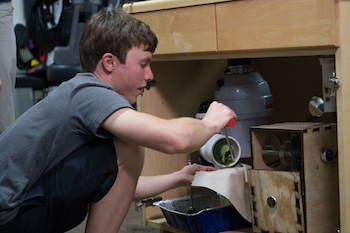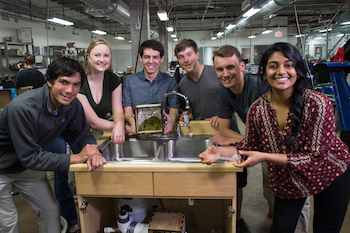
As more and more people “go green,” student engineers are trying to figure out how to turn our everyday waste food into something useful, like compost.
Engineers from Rice University have developed an integrated bio-waste processing and collection system that can be installed under kitchen sinks to collect bio-waste and separate it from the water supply.

The engineers, who make up a team called (com)post-haste, invented a device that sits under the kitchen sink, retrieves chopped up food waste from the garbage disposal and sends it in one direction while liquid waste (including water) goes in another direction. This process simplifies the act of recycling garbage into a useful product while helping to protect water supplies.
The students spent eight months working in the basement of Rice’s Oshman Engineering Design Kitchen, where they installed an actual research kitchen sink and tested the device, which they call The BioBlend.
“I think one of the major barriers to being eco-friendly in a variety of ways in the United States is people aren’t willing to put in any effort,” said Mitch Torczon, senior mechanical engineering student who helped develop the device. “This doesn’t require users to change their behaviors. They can continue putting food down the garbage disposal, and once every couple of days take it out, just like taking out their trash.”

The BioBlend produces a moist, finely chopped form of waste that takes less time to turn to compost than regular garbage. And it can even be used to generate biogas.
“One of the things our sponsors want to see is if they can make the device large enough to put in the basement of an apartment complex or a grocery store or restaurant, places with a ton of food waste,” Torczon said. “They could create a lot of biogas they could then turn around and sell or, if they’re in a restaurant, use themselves.”
According to the team, a family of four that uses a biogas generator with their waste would probably be able to generate enough gas to cook with.
The key to The BioBlend’s successful use will be its ability to keep garbage out of wastewater treatment plants, where it’s difficult to remove.
When it came time to decide on a separation method, the team tested a variety of techniques, including sewage plants to hand-cranked tabletop devices for making jellies and tomato sauce. What they came up with was a circular strainer with a large screw in the middle that pushes solid waste along while allowing liquid to escape driven by a motor. Their spring-loaded version has a failsafe to keep unwanted solids like ice from jamming the system.
The device is also equipped with a weight sensor that monitors when the bin is full in order to stop any additional food so that it doesn’t overflow. For the issue of odor, the team used a carbon filter to keep odors and keep flies away from the compost.
In the future, the team would even like to prove The BioBlend with Wi-Fi capabilities to alert users to its status via the Internet, offering a notification when the bin is full.
The BioBlend now resides in Chalmer’s University’s Living Lab where it will be tested alongside other emerging household technologies.
The project is a partnership with NASA, since the agency has an interest in developing these types of devices for outposts on the moon and Mars.

Comments are closed, but trackbacks and pingbacks are open.